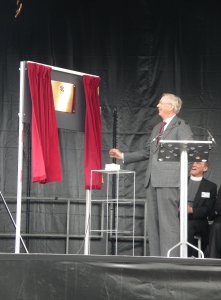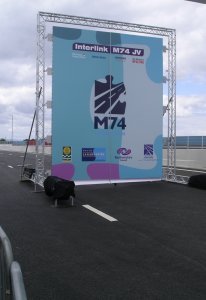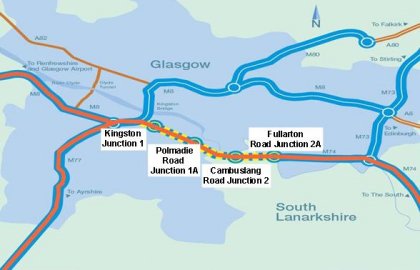M74 Completion SchemeWinner of a CEEQUAL Outstanding Achievement Award 2013 for Material Use |
82% |
Whole Project Award
Project Team:
Client: Glasgow City Council
Design: Jacobs and Atkins (Joint Venture)
Construction: Interlink M74 Joint Venture (Comprising of Morrision Contruction, Balfour Beatty, Morgan Sindall and Sir Robert McAlpine)
The Duke of Gloucester unveiling |
The ceremonial opening banner |
The Project
The M74 Completion Project completes a vital missing link in the West of Scotland’s motorway network, joining the existing M74 carriageway and the M8 motorway, and running through Glasgow City Centre.
The new motorway link is 5 miles (8.5km) in length and has 13 new bridges which allows the new link to cross the M8, existing rail lines, local roads and the River Clyde. The project is estimated to remove a significant number of vehicle movements per day from the Kingston Bridge, reducing congestion and improving local air quality.
Construction of the motorway began in May 2008, with delivery being 8 months ahead of schedule and up to £20 million below budget.
Community and Economic Regeneration
The M74 Completion Project will stimulate both economic and community regeneration within the south and east of Glasgow and will provide an opportunity for the creation of jobs in areas of high unemployment.
The improved infrastructure the M74 Completion will provide is essential both in preparing for and hosting the 2014 Commonwealth Games in Glasgow. Completing the motorway will ensure that athletes and visitors to the city will have access to the excellent transport facilities expected of a host city.
Sustainable Construction
Eleven embankments were built to accommodate the 13 new bridges of the M74. This has resulted in a net import requirement of 2.5m tonnes of structural fill. These materials have included secondary aggregates associated with other industrial processes or operations, notably red and black blaes from mining and pulverised fuel ash.
In addition, crushed and reclaimed demolition materials from notable local landmarks were utilised. Two 23-storey high rise blocks in The Gorbals area of Glasgow were crushed at source, as was concrete and demolition material arising from the former Hoover factory in Cambuslang. This provided approximately 350,000 tonnes of material to use for on-site operations. In addition, the existing M74 carriageway at Lesmahagow was resurfaced, which generated a further 30,000 tonnes of crushed concrete. This was incorporated in the new M74 embankments at Cambuslang.
The Duke of Gloucester discussing the value of CEEQUAL as an improvement tool |
Industrial Legacy
Much of the land upon which the M74 was constructed is highly contaminated with Chromite Ore Processing Residue (COPR) – a by-product of the removal of hexavalent chromium from raw minerals. The COPR contains high concentrations of chromium, with groundwater in the area containing high concentrations of leached hexavalent chromium.
The M74 Completion treated over 100,000 tonnes of COPR which was incorporated into a single embankment, very close to source and point of deposition.
Map showing the location of the M74 'Missing Link' and its relationship with other motorways in and around Glasgow. |
Recycling and Waste Management
Waste streams are segregated at source, with excellent site management being supported by the introduction of a voluntary Site Waste Management Plan which is compliant with the Regulations in England. The project team’s willingness to adopt industry best practice has seen the Waste and Resource Action Programme (WRAP) use the M74 Project as a case study in relation to voluntary introduction.
For further information please visit: www.m74completion.com




